

FOURTH ESTATE THE
FOURTH ESTATE THE
Biannual Newsletter
Department of Journalism
Lady Shri Ram College for Women
Issue 1
November 2024
“The Fourth Estate” is the biannual newsletter of the Department of Journalism at Lady Shri Ram College for Women. Coined by Thomas Carlyle in his 1841 work On Heroes and Hero Worship, the term recognises the press as a crucial, autonomous force akin to the three traditional estates of power. It underscores the media's role not merely as a conduit of information but as a vigilant guardian of democracy, upholding accountability, transparency, and civic engagement. This newsletter aspires to be a reflective lens, presenting nuanced perspectives on both departmental affairs and global issues across media, politics, culture, and social change, thereby fostering informed and meaningful dialogue.
Content Team
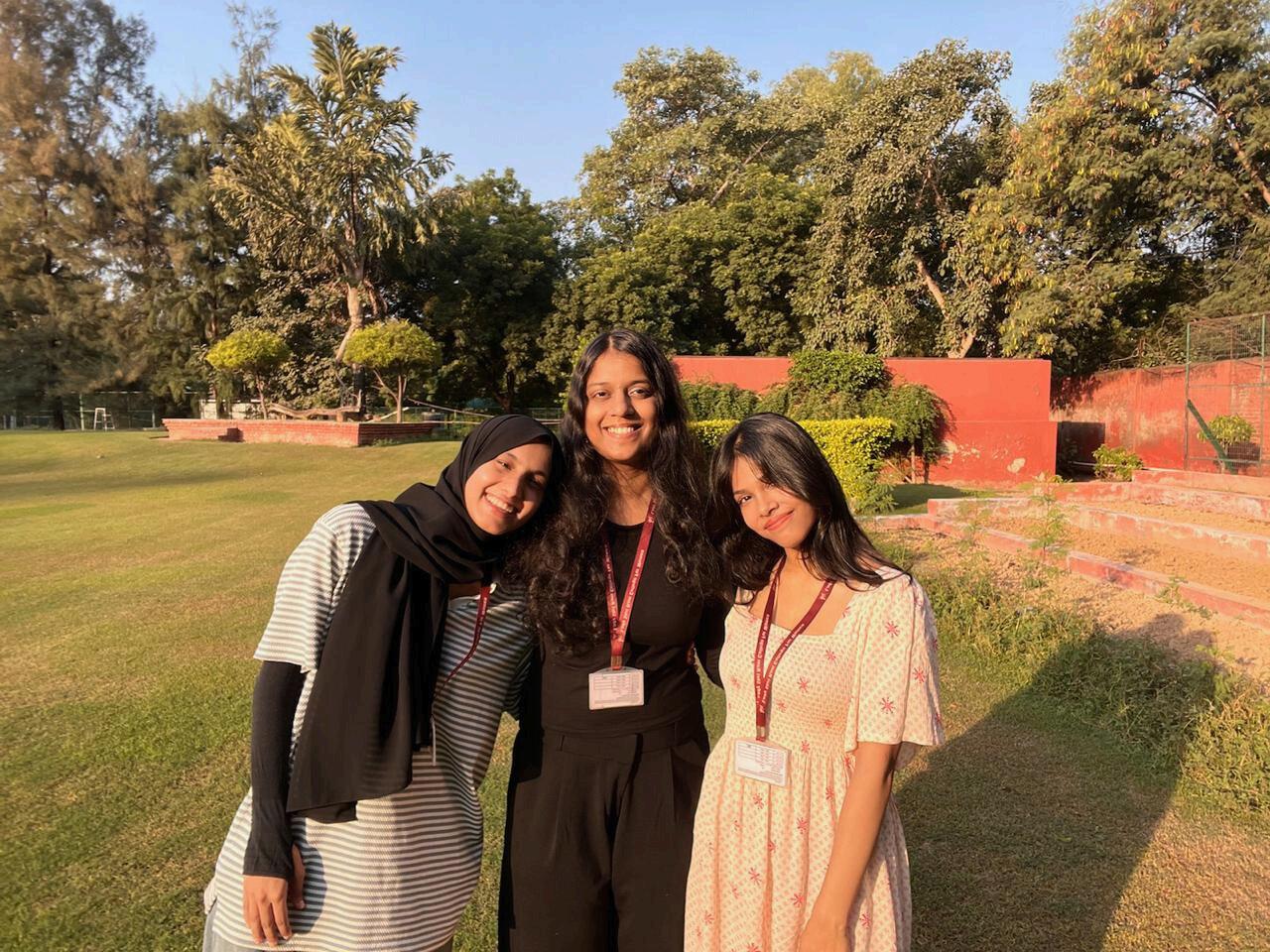
DESIGNED BY:
Nirvanika Singh
CONTENT TEAM:
Nirvanika Singh (Head)
Khansa Saleem (Sub-Head)
Anshita (Member)
This publication is solely for departmental and academic purposes. The opinions presented in the newsletter are solely those of the authors and are not reflective of the department’s position. Authors’ views are not meant to be discriminatory towards any community or social group.
(L-R) Khansa Saleem, Nirvanika Singh and Anshita
Note from the Editors
When we set out to create The Fourth Estate, we knew it had to be more than a typical newsletter filled with updates and news. We envisioned something much larger— our hope was to craft a space that captures the true spirit of journalism with all its grit, curiosity, and heart. Our vision was simple yet ambitious: to make the newsletter a mirror held up to journalism’s many faces and facets, a testament to the values that drew us to this field in the first place.
The inaugural issue is a small step towards realising this vision. Instead of confining ourselves to a single theme, we chose a wide-ranging approach for this first edition. This choice was driven by our desire to embrace a broad spectrum of perspectives, not only in the subjects we explore but also in the voices we amplify. In a world where journalism has become a mosaic of experiences—from sweeping global narratives to intimate personal stories—we wanted this first issue to capture that complexity and depth. In the following pages, you’ll encounter a plethora of subjects that blend the immediate with the timeless, a symbiosis that reflects the dynamism of our field.
Our aspiration for The Fourth Estate is for it to be a witness to the evolution of our department and serve as a record of our journey together. We wish to see this newsletter mature into a platform where stories of varied dimensions converge, a place that will spark dialogue, question conventions, and encourage critical thinking and reflection. Months of dedicated effort, collaboration, and brainstorming have condensed into the pages that follow, vividly coloured by the heartfelt creations of our department's students. As aspiring journalists at the dawn of our journey, the lack of experience is hopefully compensated for by our boundless enthusiasm, inquisitiveness, and resolve. Despite the challenges, bringing this issue to life has been one of the most rewarding experiences we’ve had.
It is our hope that within these pages, you, our reader, will encounter enduring ideas and profound insights that will leave a lasting impression long after you have turned the final page.
Welcome to The Fourth Estate. Nirvanika
Singh (Content Team Head)
Khansa Saleem (Content Team Sub-Head)
From the Union’s Desk
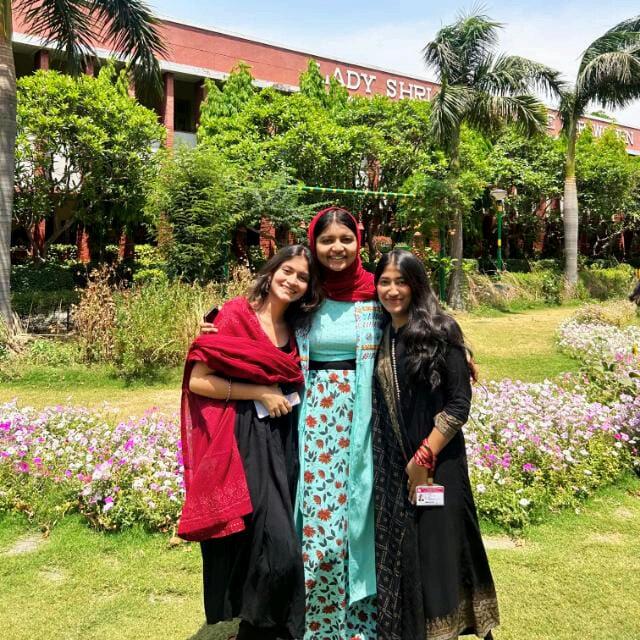
It is with immense pride that we bring to life the first edition of our department newsletter, The Fourth Estate. Here, each page is not just filled with stories but carries the footprints of our department—our experiences, passions, and voices. From the coverage of the most recent events within our community to profound reflections on global media issues, each piece reflects the dedication imprinted with our unique journey in journalism.
Thriving on a culture of dialogue and inclusiveness, we envision a space where every student is encouraged to speak up, ask, and create. Through this newsletter, we thus, aim to provide a platform for every voice to be heard and for every idea to be exchanged with free spirit in pursuit of engaging discourse and intellectual creativity. We hope it truly reflects the collective journey of all of us in their endless quest for knowledge, growth, and truth. From big-picture trends to nuanced perspectives, this issue is just the beginning of what we hope will be a thriving hub of expression and learning. With the relentless support and effort of our passionate team, we are eager to traverse more milestones as we go along.
Here’s to many more issues filled with stories that matter!!
Afza Khan (President)
Ananya Nigam (General Secretary)
Kashvi Trivedi (Treasurer)
2 COVER STORY
Offline and Left Behind: The Tale of Democracy, Disparity, and the Digital Divide by Nirvanika Singh

10 AN ACADEMIC AFFAIR
Convenience Meets Consequence: EdTech’s Double-Edged Sword by Sana Singh


5 CAMPUS CHRONICLES: DOJ TALKS by Anshita

7 PANORAMA: JOURNALISM BEYOND BORDERS by Nirvanika Singh and Deepika
Tableof CONTENTS
11 MEDITATIONS
Inheriting Rage by Disha Goyal and Vasudha Sharma
Beyond the Written Word:
Rethinking Literacy as a Catalyst for Change by Khansa Saleem
Zindagi by Somita Joiya
Barbie & Brat: The Cyclical Illusion Of Pop Culture by Disha Goyal
Daag aur Dhabbein: Embracing Vitiligo by Anandi Sarkar
The Short Clip Crisis: How Media Snippets Ascended to Mass Dominance by Malvika Anand




27 IN THE MOOD FOR CLASSICS
Movie recommendations by the content team

“Getting Past the Digital Divide” by Ben Newman
RYOFFLINE AND
LEFT
BEHIND: THE TALE OF DEMOCRACY, DISPARITY, AND THE DIGITAL DIVIDE
by Nirvanika Singh
It is important to note that the digital divide is not simply about connectivity. It represents a broader gulf in access to information, education, and opportunities for political participation.
Nearly three decades ago, when the common man’s Internet odyssey had just begun, the anticipation of unlocking the Internet’s potential was closely followed by a plethora of aspirations as well as apprehensions. Questions arose about whether the Internet would reinforce or erode the gap between information-rich and poor nations. Some feared it would exacerbate social divisions within countries, while others believed it would do much to ameliorate them.
Additionally, there was extensive debate over whether the Internet would strengthen representative democracy, as many had hoped, or reinforce existing power structures, as others dreaded. Today, with the size of the online community expanding every year, few doubt the potential importance of the Internet in driving economies, shaping societies, and empowering individuals. So profound is the Internet’s impact on modern society that access to the digital landscape has become synonymous with

access to opportunity. However, quite predictably, like a spark igniting a flame, the blaze from this invention rapidly spread through industrialized societies at the core, while smoldering more slowly among developing societies at the periphery. As a result, for millions across the globe, the door to the digital age still remains shut, creating what is known as the digital divide.

This divide—between those who have access to modern technology and the internet, and those who do not—has grave implications for democracy, equality, and the principles of societal development. It is important to note that the digital divide is not simply about connectivity. It represents a broader gulf in access to information, education, and opportunities for political participation. According to Pippa Norris, the concept of the digital divide can be understood as a multidimensional phenomenon encompassing three distinct aspects. The global divide, which refers to the divergence of Internet access between industrialized and developing societies. The social divide which is concerned with the gap between the information rich and poor in each nation. And finally within the online community, the democratic divide signifies the difference between those who do, and do not, use the panoply of digital resources to engage, mobilize, and participate in public life. Subsequently, this divide can also be understood in terms of three different levels. First is the infrastructure gap, relating to rural or underdeveloped regions. Second is the skills gap, which is concerned with the inability of individuals to make use of the technology available to them due to the lack of digital literacy. Third is the affordability gap, where the cost of devices and internet services remains prohibitive for low-income populations.
Any conversation that is centred around gauging the impact of the internet on democratic processes, hits a snag when the topic of the digital divide is brought up. At its core, democracy is all about participation and inclusion. Take, for example, Habermas’ concept of the public sphere—a space where citizens discuss and debate public issues—which is increasingly moving online, thus, making digital access crucial for democratic engagement.
Political participation now often requires a digital presence—whether through accessing government services online, participating in political movements on social media, or simply staying informed through digital news outlets. In regions where access to digital resources is limited, this exclusion becomes a form of disenfranchisement. Citizens in these areas are cut off from economic benefits and political agency, creating an uneven playing field where internet access grants a greater voice in democracy, while those without it are silenced.
The case of India, in this context is quite intriguing. While the world’s largest democracy boasts over 750 million internet users, almost half the population still remains offline, especially in rural areas with limited infrastructure and low digital literacy. This divide is also gendered and class-based, with men and wealthier, educated individuals having greater access to the internet than women and lower-income households. Despite government efforts like Digital India, barriers such as device affordability and digital illiteracy persist. This gap threatens democracy, as online access to essential services like Aadhaar leaves many excluded, deepening existing inequalities. “Democracy is hollow without equality, and in today’s world, equality requires digital inclusion.” Addressing the digital divide requires a multi-faceted approach. Infrastructure investment is crucial to bringing connectivity to underserved areas, while education initiatives must be implemented to improve digital literacy.
Equally important is the need to address affordability, ensuring that low-income populations can access devices and internet services. Economist Amartya Sen's concept of "capabilities" is highly relevant here. He argues that development should not be measured solely by economic growth but by the ability of individuals to exercise agency and participate fully in society. In the digital age, access to the internet is an essential capability, without which individuals cannot fully realise their potential. Furthermore, governments must ensure that the shift toward digital governance does not leave behind those without access. Public services must continue to be available in non-digital formats, ensuring that all citizens, regardless of their digital connectivity, can engage with the state.
It is crucial to bear in mind the fact that the digital divide is more than a technological issue—it is a matter of equity, democracy, and human rights. In today’s world, the channels through which people assert and express themselves in society have become increasingly digital and those without access to such media are being denied a fundamental means of engaging in public discourse. Addressing the digital divide is imperative to ensure equitable access to these instruments of empowerment and inclusion.
WELCOME TO THE ELECTRIC ATMOSPHERE OF DOJ!
The Department of Journalism at Lady Shri Ram College for Women is a hive of activity and vibrancy all year round. It’s a place where hustle and bustle are the norm, and exuberance defines the spirit. Here, you’ll never find yourself vegetating between copious assignments and ceaseless events, you’ll be fully immersed 24/7. While the pace may tire you out, it also ensures that you find your true home amidst the delightful chaos.



READING CIRCLE
August 23, 2024: Our semester kicked off with an intellectually stimulating Reading Circle, organized by the Books and Library Team ( Disha Goyal and Nausheen Khan). We delved into Haruki Murakami’s enigmatic worlds with 1Q84 and Kafka on the Shore, sparking engaging discussions and deep literary dives.
The Class of 2027/28 was welcomed with effervescent enthusiasm. The orientation was a vibrant kaleidoscope of colors and energy, marking the beginning of their exciting academic voyage with infectious zeal.

C A M P U S C H R O N I C L E S
TEACHER’S DAY CELEBRATION
On September 12, 2024, the Department of Journalism celebrated Teacher’s Day with a blend of heartfelt tributes and lively performances. The event began with a touching video where students shared their gratitude, setting a reflective tone. Arya’s classical dance captivated the audience, followed by evocative poetry from Akanksha, Jiya Gupta, and Ananya. Chahak and Ananya Sharma’s musical performance resonated deeply with everyone. The first-year students energized the room with a dynamic group dance, featuring Malvika, Bhuvi, Janhavi, Sneha, Nidhi, Falak, Aardra, Rinki, and Nimmi. The celebration concluded with a cake-cutting ceremony in honour of our teachers.
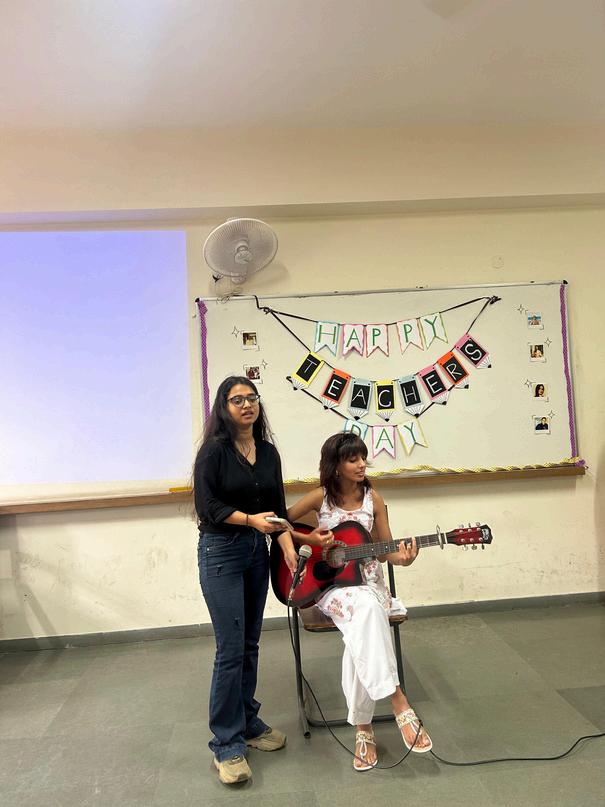

FRESHERS': A FAIRY TALE FANTASY

The Department of Journalism hosted its Freshers' event on the 18th of September, marking a day brimming with excitement and enchantment. The atmosphere was filled with joy and celebration, as cheers resonated throughout the room, fuelled by captivating performances, engaging interactions, and fun-filled games.
Key highlights of the event included:
- The dazzling ramp walk of the freshers, showcasing their style and confidence.
- A graceful solo dance performance by Yogita, leaving the audience mesmerized.
- Suhani and Bipasha’s captivating duet, which drew everyone’s attention with its charm.
- An energetic group dance by Kanika, Shreya, Deepika, Kashvi, Trisha, Ridhima, and Sana, infusing the room with palpable excitement.
The event perfectly embodied the theme of 'Fairytale Fantasy,' creating a magical experience for all in attendance.
At DOJ, monotony is a foreign concept. From engaging events to enriching experiences, the Department of Journalism ensures that every moment is teeming with excitement and discovery.
PANO Journalism
ACCORDING TO A REPORT FROM THE REUTERS INSTITUTE AT THE UNIVERSITY OF OXFORD, OVERALL TRUST IN THE MEDIA AMONG THE CANADIAN POPULATION HAS FALLEN FROM 55 PERCENT IN 2016 TO 40 PERCENT IN 2023 NEW POLLING SHOWS GOVERNMENT FUNDING OF THE NEWS INDUSTRY COULD FURTHER ERODE CANADIANS’ TRUST IN THE MEDIA

THE DEBATE OVER MISINFORMATION AND DISINFORMATION REMAINS CENTRAL, ESPECIALLY IN THE RUN-UP TO THE 2024 ELECTIONS. MEDIA OUTLETS ARE NAVIGATING POLITICAL POLARIZATION, WITH SIGNIFICANT ATTENTION ON AI-GENERATED NEWS AND MISINFORMATION REGULATION

PRESS FREEDOM IN MEXICO IS SEVERELY THREATENED BY VIOLENCE, IMPUNITY, AND SELF-CENSORSHIP, ESPECIALLY CONCERNING CRIME REPORTING ACCORDING TO REPORTERS WITHOUT BORDERS, THE MEXICAN GOVERNMENT HAS FAILED TO ADEQUATELY PROTECT JOURNALISTS, WITH MORE THAN 150 MEDIA PROFESSIONALS KILLED SINCE 2000.

JOURNALISM IS AT A CROSSROADS, WITH ECONOMIC CRISES LIMITING THE ABILITY OF INDEPENDENT MEDIA TO THRIVE THERE ARE CONCERNS OVER GOVERNMENT INFLUENCE ON STATE-RUN MEDIA THE ARGENTINE JOURNALISM FORUM HAS DENOUNCED AN "ORGANIZED ATTACK" ON SOCIAL MEDIA AND MILEI'S "GROWING HOSTILITY" AGAINST JOURNALISTS
IN BRAZIL, OVER 37,000 ONLINE ATTACKS AGAINST JOURNALISTS WERE RECORDED IN ONE MONTH, PARTICULARLY AS LOCAL ELECTIONS APPROACH THIS SURGE IN ATTACKS REFLECTS AN INCREASINGLY HOSTILE ENVIRONMENT FOR JOURNALISTS, DRIVEN BY POLITICAL TENSIONS AND THE UPCOMING ELECTORAL CONTEXT



THE NIGERIAN MEDIA INDUSTRY RECENTLY ADOPTED A NEW COREGULATION FRAMEWORK AND REVISED THE CODE OF ETHICS TO IMPROVE PROFESSIONALISM AND ADDRESS ETHICAL ISSUES THE NEW FRAMEWORK INCLUDES AN OMBUDSMAN SYSTEM FOR HANDLING VIOLATIONS OF PROFESSIONAL STANDARDS, ENSURING SELFREGULATION BY MEDIA ORGANIZATIONS
RAMA
Beyond Borders
PRESS FREEDOM REMAINS SEVERELY RESTRICTED, WITH THE GOVERNMENT CONTROLLING MEDIA NARRATIVES THE DETENTION OF CONTENT CREATORS AND JOURNALISTS CONTINUES, WITH THE INTERNATIONAL COMMUNITY CALLING FOR THEIR RELEASE


THE GOVERNMENT’S INCREASING CONTROL OVER ONLINE CONTENT AND SURVEILLANCE IS SHAPING THE MEDIA LANDSCAPE NEW AMENDMENTS TO THE DIGITAL MEDIA ETHICS CODE ALLOW GREATER CENSORSHIP, FURTHER TIGHTENING FREEDOM OF EXPRESSION


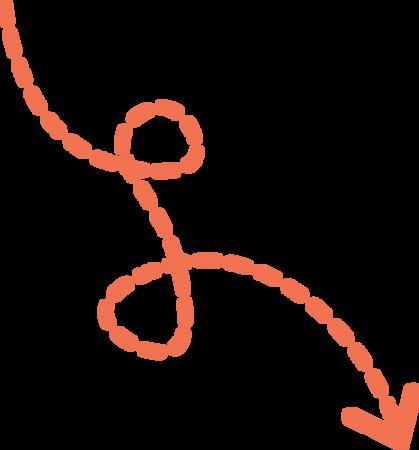
THE BANGLADESHI GOVERNMENT RECENTLY ANNOUNCED THAT IT WOULD REPEAL THE CONTROVERSIAL DIGITAL SECURITY ACT (DSA), WHICH HAS BEEN USED TO TARGET JOURNALISTS AND POLITICAL OPPONENTS. IT IS TO BE REPLACED BY THE CYBER SECURITY ACT, WHICH AIMS TO REFORM PARTS OF THE PREVIOUS LAW HOWEVER, CRITICS ARGUE THAT THIS REFORM IS INSUFFICIENT, AS THE NEW DRAFT LAW RETAINS SOME OF THE VAGUE AND REPRESSIVE SECTIONS OF THE DSA, POTENTIALLY ALLOWING AUTHORITIES TO CONTINUE USING IT AGAINST CRITICAL VOICES.
PRESS FREEDOM IN RUSSIA IS HEAVILY RESTRICTED, WITH STATE-CONTROLLED MEDIA DOMINATING INDEPENDENT JOURNALISTS FACE CENSORSHIP, HARASSMENT, AND IMPRISONMENT, PARTICULARLY THOSE CRITICAL OF THE GOVERNMENT OR REPORTING ON SENSITIVE POLITICAL ISSUES
JOURNALISM REMAINS UNDER PRESSURE, ESPECIALLY IN HONG KONG, WHERE THE CONVICTION OF TWO FORMER EDITORS OF STAND NEWS HIGHLIGHTS CHINA'S INCREASING CONTROL OVER THE MEDIA, CRIMINALIZING DISSENT AND RESTRICTING JOURNALISTIC FREEDOMS

AUSTRALIA IS INTRODUCING A LEGISLATION TO FINE INTERNET PLATFORMS FOR FAILING TO PREVENT THE SPREAD OF MISINFORMATION ONLINE THE LEGISLATION TARGETS FALSE CONTENT THAT COULD HURT ELECTION INTEGRITY OR PUBLIC HEALTH, OR RISK DISRUPTING KEY INFRASTRUCTURE OR EMERGENCY SERVICES IN JULY 2024, JOURNALISTS AT SEVERAL AUSTRALIAN NEWSPAPERS WENT ON A STRIKE TO FIGHT FOR BETTER WAGES, IMPROVED DIVERSITY, AND SAFEGUARDS AROUND AI

Artwork by CurtnerArt (Pinterest)
N A C A D
CONVENIENCE MEETS CONSEQUENCE: EDTECH’S
DOUBLE-EDGED SWORD
by Sana Singh
Striking a balance between leveraging EdTech resources and preserving traditional approaches to studying is crucial.
The topic of online education and EdTech always brings to my mind one particular story. “The Fun They Had” was a sci-fi story written by Isaac Asimov that had been taught to us in the ninth grade. Set in the 22nd century, it covers the lives of two kids Margie and Tommy. It describes a time where the concept of schooling means a robotic teacher teaching the students personally at their homes, quite contrary to the traditional concept of school, we’re all familiar with. To those kids, the notion of a large group of students gathered in a single building, learning from a human teacher, feels completely unreal. It’s ironic that before the Covid-19 pandemic, the characters in the story viewed ‘physical teaching’ as something unimaginable, while the students reading it found the idea of ‘online teaching’ equally farfetched. The Covid era brought this story to life much sooner than expected, made possible by the rise of EdTech—one of the defining features of recent years.
The positive side of online education has always been well-highlighted. It has undeniably improved access to information, learning flexibility, resource diversity, and availability of study materials. However, just as every coin has two sides, this revolution also brings with it certain challenges. With increased options,
students often jump between resources, hindering deep understanding, or rely on a single platform, resulting in incomplete knowledge. “As platforms like ChatGPT are available I have found myself waiting till the last moment to start preparing for my exams”, says Shree Dawar, a second-year student at Miranda House. Delayed prep as a result of EdTech platforms, comes at the cost of one’s mental health. Students are faced with an overwhelming amount of stress to cover the entire syllabus in a few days. Such preparation focuses on exams rather than true understanding.
“Upon some self-reflection I have realised I struggle in paying attention in physical classes since at the back of my mind, I know I can understand the same concept from Youtube videos”, explains Sidra Khan, a first-year student at Jamia Millia Islamia. Many EdTech platforms use shortcuts to help students find answers, but they often fail to teach the underlying concepts, thus undermining critical thinking and problem-solving skills necessary for exams.
Many negative impacts of EdTech are indirect and subtle, yet they warrant discussion. While EdTech tools offer convenience, traditional study methods still remain quite relevant. Striking a balance between leveraging EdTech resources and preserving traditional approaches to studying is crucial.
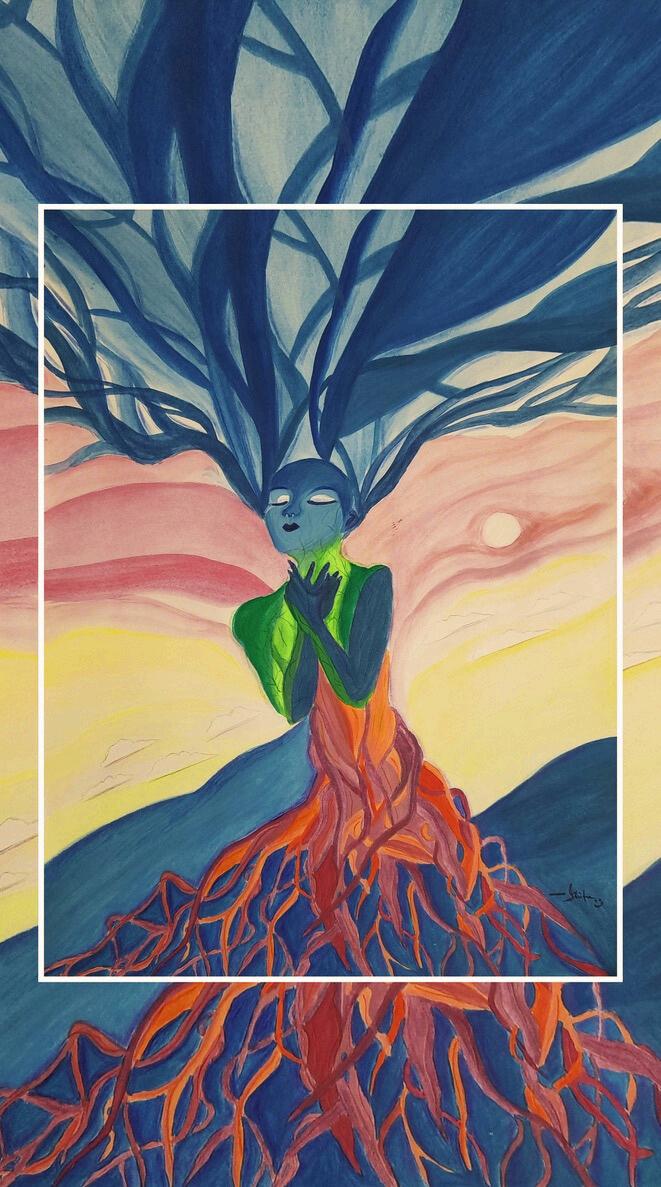
M E D I T A T I O N S
Artwork by Ishita Das
INHERITING RAGE
THIS PHOTO STORY PORTRAYS POWERFUL MOMENTS FROM THE SOLIDARITY MARCH ORGANISED BY STUDENTS OF LADY SHRI RAM COLLEGE FOR WOMEN, IN SUPPORT OF THE VICTIM OF THE RG KAR COLLEGE RAPE-MURDER CASE.






Photos by Disha Goyal and Vasudha Sharma







Photos by Priyanka Gupta

BEYOND THE WRITTEN WORD: RETHINKING LITERACY AS
A CATALYST FOR CHANGE
by Khansa Saleem
Will literacy alone suffice? In a world where being literate no longer guarantees opportunity or dignity, can we still claim it as the solution?
Every year, on September 8th, the world celebrates World Literacy Day. As organizations release literacy rates, the familiar cycle begins: surveys are conducted, data is analyzed, nations are compared, and strategies are drafted. The aim is always the same—improve literacy, boost human capital, and foster development. Year after year, governments, institutions, and policymakers create programs to enhance literacy. But even as these initiatives expand, one question persists: Why is literacy still considered a privilege, and is it truly enough?
The world functions on different axes for each of us, yet everyone is in the rat race to provide and succeed. While being literate and educated can lead to better jobs and opportunities for a comfortable lifestyle, a larger part of literacy involves the ability and prospect to communicate effectively and act rationally so that issues can be discussed and addressed, thereby contributing productively to society. For many in the privileged class, education is a tool to climb the social ladder and secure white-collar jobs. For many others, being surrounded by books of knowledge and participating in public discourse remains a distant dream. While the educated elite deliberate societal issues from the comfort of their leather armchairs, the less fortunate often yearn for a chance to write their own stories and speak for their communities. Thus, literacy remains a privilege rather than a universal right, even as we mark the 57th World Literacy Day.
Consequently, we must ask: Will literacy alone suffice? In a world where being literate no longer guarantees opportunity or dignity, can we still claim it as the solution?
When those who can read and write are neglected by a society that now prioritizes the extremely skilled and resourceful, and a significant portion of society continues to perform unpaid labor in harsh conditions and lacks access to basic amenities, why is the intellectual elite not doing enough to drive change? Where is this education and training leading us? Despite being literate, many people still perpetrate brutality and cling to superstition, their words are filled with hatred and betrayal, with morality often being sidelined. Politicians and the educated still perpetuate bias and propaganda, driven by greed and corruption.
If literacy alone isn't sufficient to engage people in meaningful conversations or inspire them to support those in need, then why do we consider ourselves the educated elite? If our written and spoken words do not foster goodwill and reform, we must strive for improvement. Perhaps the next time we are in classrooms and conferences, we should not only focus on formal education and discussions but also cultivate a sense of responsibility and empathy.
To be literate is to have the ability to read and write one's language. But will literacy alone make a person competent enough to communicate effectively? The skill of etching words onto paper and breathing them into existence might be developed,
but does it suffice for creating meaningful change? Will the skill itself lead to reformation, or will it disintegrate into wasted potential? For productive output to be achieved, one must not only possess the skill but also use it for the greater good. If given the power of words, why not use them to be a change-maker?
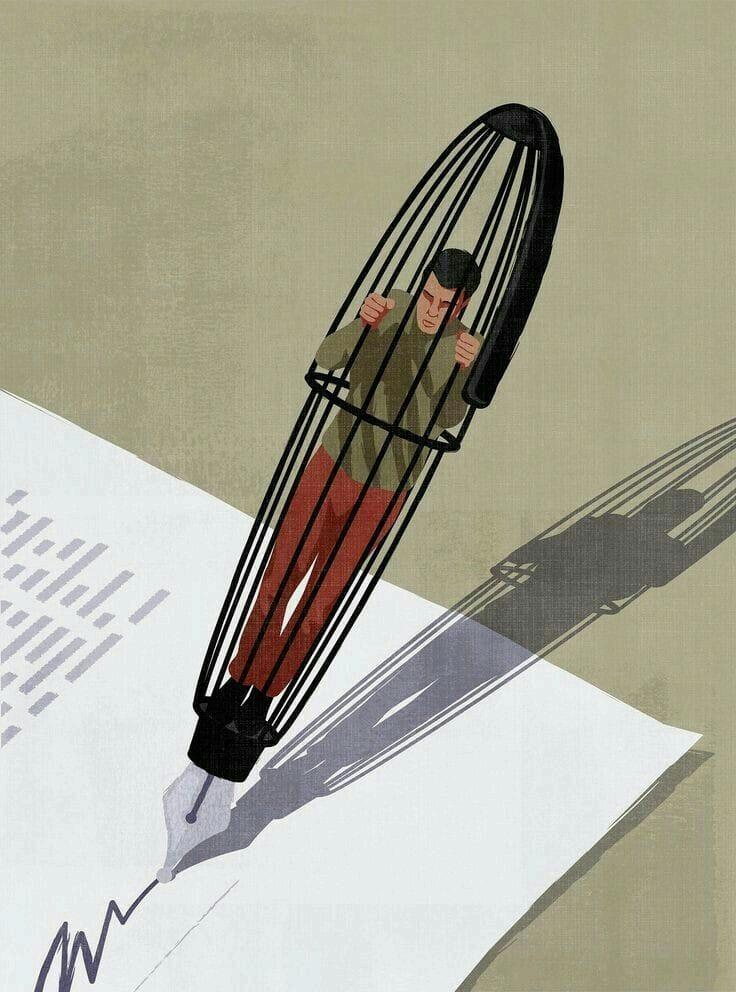
by Random House
Photograph by Aditi Chauhan



Artwork by Liz Ganim (Pinterest)
BARBIE & BRAT: THE CYCLICAL ILLUSION OF POP CULTURE
by Disha Goyal
The cyclical nature of pop culture serves as a reminder of the fact that what we often perceive as new and innovative is merely the latest iteration of an enduring pattern of cultural recycling.
The phenomena of Greta Gerwig's Barbie (2023) and Charli XCX's Brat (2024) exemplify the strategic manipulation of pop culture to generate mass appeal and commercial success. These cultural products are not groundbreaking or original in their concepts but are instead calculated marketing strategies designed to resonate with contemporary audiences by tapping into existing cultural currents. The success of these works lies in their ability to repurpose and repackage familiar ideas, presenting them as fresh and relevant through the lens of current societal trends.
Barbie achieved unprecedented popularity in 2023, not because of its innovative narrative or profound message, but because it was cleverly marketed as a symbol of a particular brand of feminism that resonated with a broad audience. This "white woman feminism"—a term often used to describe a mainstream, surface-level approach to gender equality— leveraged the nostalgia associated with the Barbie doll, a cultural icon that many people grew up with. The film's success was further amplified by its impact on fashion and consumer goods, with the proliferation of "Barbiecore" aesthetics influencing everything from clothing lines to home decor. One cannot overlook the way it completely changed the content that was created and consumed on digital media. If you had even a slight interest in America centric pop media, there was no escaping either of these trends. The widespread adoption of this trend illustrates how effectively the film tapped into our collective consciousness, using nostalgia and a palatable form of feminism to drive consumer engagement.

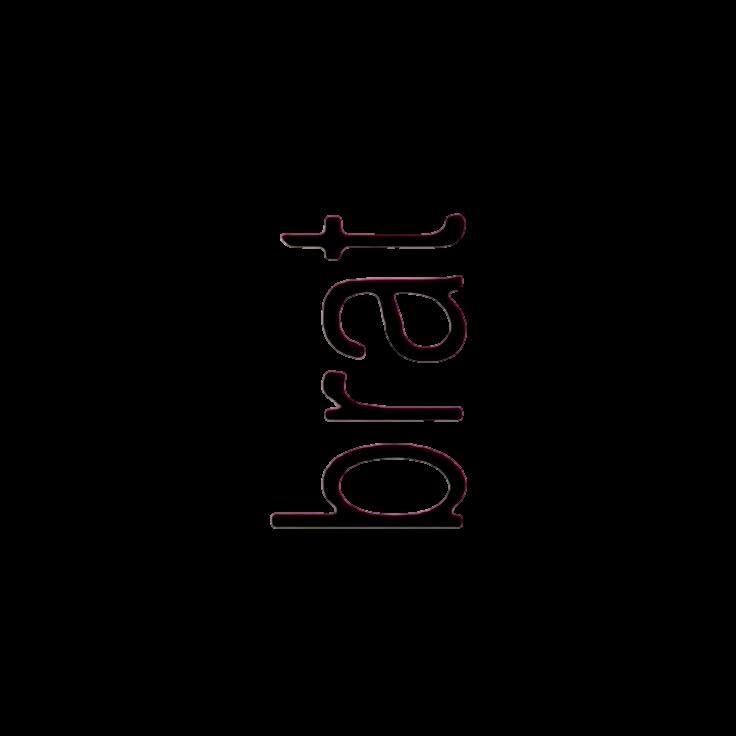
In contrast, Brat by Charli XCX in 2024 capitalized on the very hype generated by Barbie, but with a deliberate aesthetic and conceptual inversion. Drawing from the legacy of the Bratz dolls, which were marketed as Barbie's edgy competitors in the early 2000s, Brat positions itself as the antithesis of the Barbie phenomenon. Where Barbie embraced pastels and the polished "clean girl" aesthetic, Brat adopts a grungy, punkinspired style with neon greens and bold contrasts, challenging the previous year's trends. However, this rebellion is not as original as it might seem. The name "Brat" itself is a direct reference to the Bratz dolls, and the album's concept is a calculated move to position Charli XCX within the same cultural discourse, albeit from an opposing standpoint.

Looking ahead, it’s plausible that the next big trend will once again flip the script, perhaps embracing darker, more introspective aesthetics concentrating on refined, intellectual, or romantic themes, such as dark academia, vintage elegance, or classical influences, that revolve around the pursuit of classical education, literature, and the arts rather than the rebellious and high-octane energy of Brat.
The style perhaps will draw heavily from the gothic and preppy influences, with an emphasis on soft, muted tones such as pastels, earth tones, and neutrals focusing on luxurious, high-quality fabrics like silk, velvet, and wool, contrasting with bright neon colours and the more casual and rugged materials associated with Brat. An elegant and sophisticated look, potentially embracing minimalist or classic fashion rather than the bold, eclectic, and edgy style of Brat whilst embracing the melancholic spirit reminiscent of Dead Poets Society and rediscovery of classical music might be where we are headed. This trend might also tap into a connection with nature, but in a moody, mist-covered forest atmosphere, offering a stark contrast to the neon, punk energy of Brat. But that's merely my prediction and time shall tell soon enough.
extent but also criticized by the subculture community that already embraces this way of life. Despite grace and timelessness being the nexus of this trend, it will succumb to overexposure and overuse by the masses, causing it to quickly fade away. This cyclical nature of pop culture serves as a reminder that what we often perceive as new and innovative is merely the latest iteration of an enduring pattern of cultural recycling.

Although, if this trend emerges, it will likely manifest in a superficial, mass-consumerfriendly and a capsulated digestible form rather than in a deeply committed way which will likely be celebrated to some

Artwork by Vika Mahovskya

One day, I turned to my parents and told them about my wish to live a normal life, free from constraints and medication. I wanted to embrace my spots because, at the end of the day, they are a part of who I am.
As a 2-year-old, I was subjected to a multitude of dietary restrictions. I couldn’t eat citric foods, sweet treats, or even meat for years. I was not allowed to play, not allowed to go out when it was sunny, was banned from consuming packaged food, and had numerous other restrictions imposed on me in order to “ manage” the mere presence of certain spots on my skin. As I grew older, the burden of taking ten different medications daily and adhering to countless restrictions became overwhelming. One day, I turned to my parents and told them about my wish to live a normal life, free from constraints and medication. I wanted to embrace my spots because, at the end of the day, they are a part of who I am. I thought self-love would come easily, but I quickly learned it wasn’t as simple as I had hoped.
I turned 14 and all the teenage insecurities caught up to me. In addition to having a frustrating existence, I was also bullied by my classmates. A friend said I’d look better if I removed my facial spots. It was and is still really sad to see people having too many opinions on my body and life. Every day, I have to put on a brave face to go out, because I never know when a random person may show up and point out my insecurities in harsh/concerning/patronizing ways—all of which were unsolicited. Navigating this as a female made it even harder.
Social media often promotes the idea of embracing one's spots, yet many who advocate this still cover their spots in real life, which can be confusing and disheartening for teenagers who look up to them. There is almost no representation of people with vitiligo in Indian media. If there is any occasional representation, they portray it as “you are beautiful despite your vitiligo” and not just beautiful. This lack of representation leads to the prevalence of stereotypes such as the erroneous beliefs that vitiligo is caused by eating fish and milk together, or that it is contagious. Many people mistakenly think vitiligo discoloration is caused by burns.
In India, people use the word “दाग
” (scars and spots) which has a clearly negative connotation. Many doctors and priests claim that they can cure vitiligo in months. All of this is a lie because there is scientific research that clearly states, vitiligo is not curable. Throughout this time, social media has become my biggest enemy. The unrealistic beauty standards and notions of how a girl should look profoundly affected me. Admitting that I stopped viewing my friends' posts because I felt inadequate was difficult. I tried to cover my face with hairstyles or layers of makeup, only to end up crying when I saw the uneven skin tone. Every morning was a struggle, and my reflection often led to tears.
Dealing with Vitiligo was and still is the biggest struggle of my life, but I found my family to be my biggest supporter in this storm. They have always been by my side through thick or thin. However, in a Bengali household, everyone is fond of eating non-vegetarian food. Even then, my family supported me by following the same diet as mine so that I don’t feel bad. My mother made every packaged food at home because I used to feel left out when other kids ate chips, fries, sauce, and other packaged food that I was not allowed to eat. My mother made everything from scratch without citrus and preservatives just to see me happy. She was a working lady who’d come home and then spend the rest of her day in the kitchen just to see her child smile. I remember how challenging it was for my father to take leave from work to accompany me to a doctor two hours away. My sister stood by me, taking a stand whenever I needed support.
Recently, I realized that my social media posts predominantly feature images where my spots are less visible, thanks to filters and makeup. This realization made me feel fake and disappointed in myself for not fully embracing who I am. The struggle to meet beauty standards and portray an ideal image was taking a toll. However, I have realized that vitiligo will always remain a part of me but it is in no way, a setback to my identity. I have endured all this struggle, all these medicines, and pain because somewhere down the line I have realized how wonderful being alive is and can be. And if I can become an ally or a support system to any other person who wears the same shoes as me, I would be more than glad to do that.


THE SHORT CLIP CRISIS: HOW MEDIA SNIPPETS ASCENDED TO MASS DOMINANCE
by Malvika Anand
The very features that make short video platforms engaging also make them addictive, fostering unhealthy habits of prolonged scrolling and reduced attention spans.
How often do you find yourself scrolling through a stream of brief and engaging videos, only to realise hours have passed? More often than you'd like to admit, I'm sure.
Well, you're certainly not alone. Short video platforms like TikTok, Instagram Reels, and YouTube Shorts have emerged as powerful forces in digital media, capturing our attention and completely reshaping the manner in which we consume content. From makeup tutorials and skincare tips to educational content and local news, these
platforms have evolved into diverse hubs of information and entertainment. The concept of short videos isn't entirely new. Platforms like Vine, which launched in 2013, were pioneers in popularising the format with their 6-second looping videos.
Vine’s success proved that users were drawn to quick, easily consumable content.In 2016, ByteDance launched Douyin in China, rebranded as TikTok for international markets in 2018. TikTok’s algorithm-driven
feed and user-friendly editing tools quickly captivated a global audience, establishing it as a major player in the short video landscape. Following TikTok’s success, other media companies introduced similar features. In August 2020, Instagram launched Reels to compete with TikTok, and in September 2020, YouTube introduced Shorts, allowing users to create and watch 60-second videos. The rapid adoption of short videos clearly highlights their significant impact on social media users. But what makes these platforms so captivating? Short videos cater to our shrinking attention spans and provide instant gratification.

The brief format is easy to consume and encourages continued engagement. Additionally, the algorithms behind these platforms personalise content feeds, presenting users with a continuous stream of videos tailored to their interests. However, this personalization can also lead to echo chambers, where users are exposed to limited viewpoints and potentially misleading information. The very features that make short video platforms engaging also make them addictive, fostering unhealthy habits of prolonged scrolling and reduced attention spans. As algorithms push personalised content, users may become ensnared in cycles of mindless consumption, limiting their exposure to diverse perspectives.
Thus, while the rise of short videos marks a new era in media, it's crucial to be mindful of the potential negative impacts on both individual well-being and broader societal engagement.

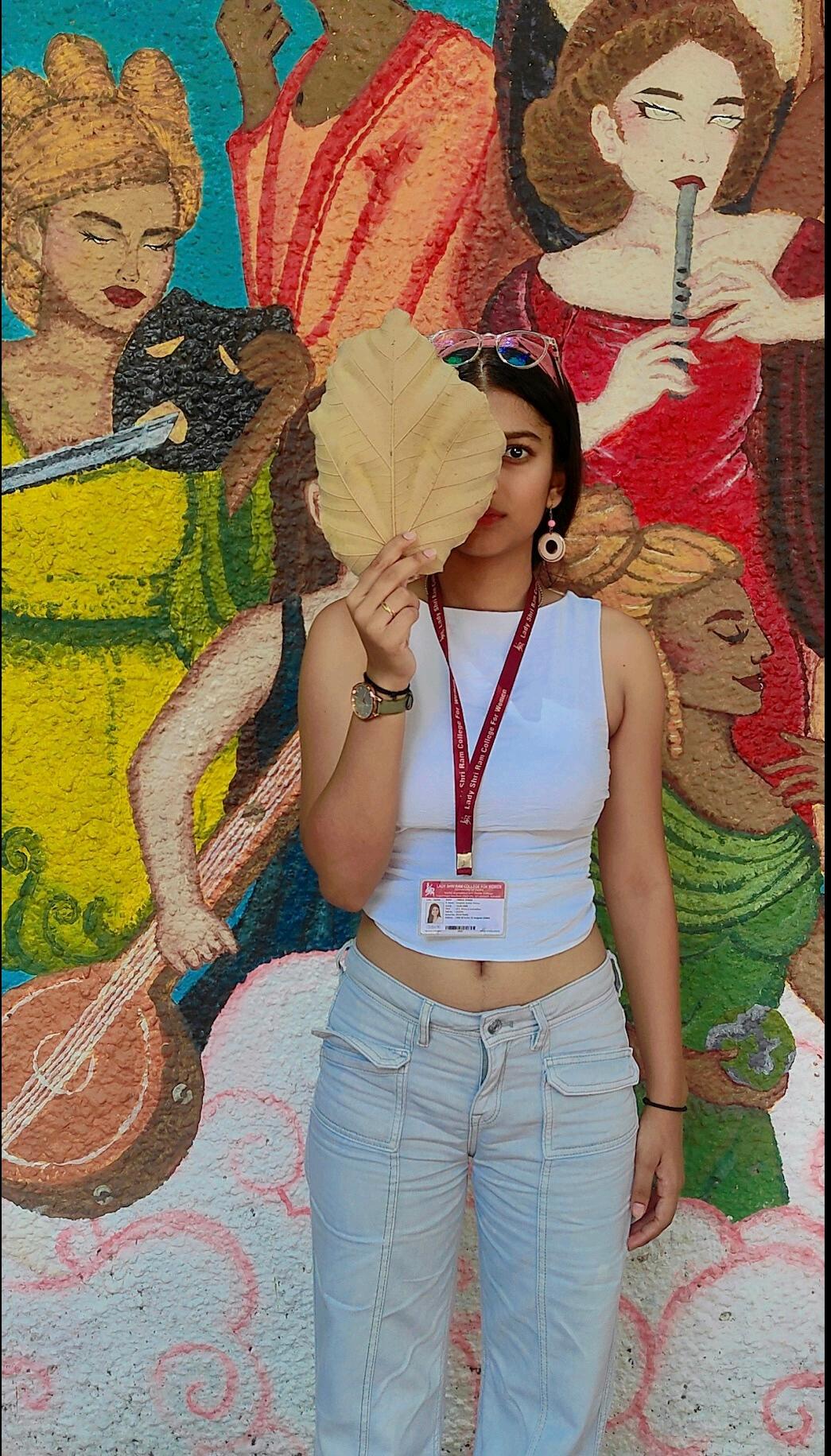
Photo by Lakshmi Priya Ghosh





Explore this curated selection of cinematic gems that showcase the best of both the present and the past.
In the Mood for Classics
Explore the sharp edge of political satire with these five films that cleverly dissect media manipulation and power dynamics. Through humor and incisive commentary, they unveil the absurdities of politics, offering both entertainment and a critical lens on contemporary issues. Dive into a world where satire meets political critique.
DR. STRANGELOVE OR: HOW I LEARNED TO STOP WORRYING AND LOVE THE BOMB (1964)


Directed by Stanley Kubrick, this black comedy satirizes the Cold War mentality and the nuclear arms race It portrays a series of absurdly incompetent decisions by military and political leaders that lead to a potential nuclear disaster, exposing the ridiculousness of the doctrine of mutually assured destruction.
JAANE BHI DO YAARO (1983)
This Hindi dark comedy, directed by Kundan Shah, critiques corruption in Indian politics and bureaucracy. Through a chaotic series of events following two photographers' accidental capture of a murder, it lampoons the systemic corruption and moral decay prevalent in society.

ACE IN THE HOLE (1951)

Directed by Billy Wilder, this film satirizes media sensationalism and the exploitation of human tragedy for profit. It follows a disreputable reporter who manipulates a mining accident to create a sensational story, showcasing the unethical lengths to which media professionals might go for headlines.
NETWORK (1976)
Directed by Sidney Lumet and written by Paddy Chayefsky, this film presents a scathing critique of the television industry and its exploitation of sensationalism and audience manipulation It tells the story of a news anchor whose on-air breakdown becomes a media spectacle, reflecting the industry's prioritization of entertainment over journalism.

THE DEATH OF STALIN (2017)
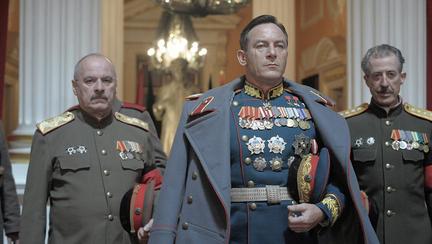
Directed by Armando Iannucci, this dark comedy lampoons the chaotic power struggle following the death of Soviet dictator Joseph Stalin. It highlights the absurdity and brutality of the political purges and the often farcical nature of the scramble for power within the Soviet regime.
Front Cover Design: Nirvanika Singh
Front Cover Illustration: Khansa Saleem
